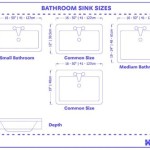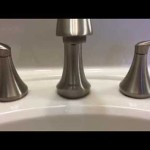Recessed Lights in Bathroom Designs: A Comprehensive Guide
Recessed lighting, also known as can lights or pot lights, has become a prevalent choice for bathroom illumination. Its popularity stems from its sleek, minimalist aesthetic, space-saving design, and ability to provide effective, even lighting. Properly implemented recessed lighting can significantly enhance the ambiance and functionality of a bathroom, while improper installation can lead to inadequate lighting, glare, and even safety hazards. This article aims to provide a comprehensive guide to using recessed lighting in bathroom designs, covering key considerations from planning and selection to installation and maintenance.
The selection of appropriate recessed lights for a bathroom requires careful consideration of several factors, including the type of light fixture, bulb type, spacing, and placement. Understanding these aspects is crucial to achieving the desired lighting effect and ensuring compliance with safety regulations.
Understanding Recessed Light Housing Types
Recessed light housings are categorized based on their suitability for different ceiling types and insulation conditions. The most common types include IC-rated and non-IC-rated housings. IC-rated housings are specifically designed to be in direct contact with insulation, making them ideal for bathrooms with insulated ceilings. These housings feature a protective barrier that prevents heat from the bulb from igniting the insulation. Non-IC-rated housings, on the other hand, are not designed for direct contact with insulation and require a minimum clearance of 3 inches from any insulation material. Using a non-IC-rated housing in an insulated ceiling can create a fire hazard. In addition to IC and non-IC ratings, some housings are classified as airtight, minimizing air leakage and improving energy efficiency. This is particularly beneficial in bathrooms where moisture and humidity levels are typically higher.
Shallow housings are designed for installations where ceiling space is limited. These housings have a lower profile compared to standard housings, making them suitable for situations where ductwork or other obstructions are present above the ceiling. The choice of housing type depends on the specific characteristics of the bathroom's ceiling structure and insulation.
Selecting the Right Bulb Type for Bathroom Recessed Lighting
The choice of bulb type significantly impacts the overall lighting quality and energy efficiency of recessed lights. Several options are available including incandescent, halogen, LED, and compact fluorescent (CFL) bulbs. Each type offers distinct advantages and disadvantages in terms of light output, energy consumption, lifespan, and color rendering.
Incandescent bulbs, while relatively inexpensive, are energy-inefficient and have a short lifespan. Halogen bulbs offer brighter light and longer lifespan compared to incandescent bulbs but still consume more energy than LED or CFL options. CFL bulbs are more energy-efficient than incandescent and halogen bulbs but contain mercury and require careful disposal. LED bulbs have emerged as the preferred choice for recessed lighting due to their exceptional energy efficiency, long lifespan, and excellent color rendering capabilities. LED bulbs are available in a wide range of color temperatures, allowing for customization of the bathroom's ambiance. Furthermore, LED bulbs produce less heat compared to other bulb types, reducing the risk of overheating and extending the lifespan of the recessed light fixture.
When selecting LED bulbs, it is essential to consider the lumen output, which measures the brightness of the light. The appropriate lumen output depends on the size of the bathroom and the desired level of illumination. For general bathroom lighting, a lumen output of 500-800 lumens per fixture is typically recommended. Color temperature, measured in Kelvin (K), affects the perceived warmth or coolness of the light. Warmer color temperatures (2700K-3000K) create a cozy and relaxing atmosphere, while cooler color temperatures (4000K-5000K) provide a brighter and more energizing light. The selection of color temperature depends on the desired aesthetic and functional requirements of the bathroom.
Optimal Placement and Spacing of Recessed Lights
The placement and spacing of recessed lights are critical for achieving uniform and effective illumination in the bathroom. Poorly placed or spaced lights can create shadows, glare, and uneven lighting, detracting from the overall aesthetic and functionality of the space. A general guideline for spacing recessed lights is to divide the ceiling height by two. For example, in a bathroom with an 8-foot ceiling, the lights should be spaced approximately 4 feet apart. This guideline may need to be adjusted based on the size and shape of the bathroom, as well as the lumen output of the selected bulbs.
Specific areas of the bathroom require different lighting considerations. Above the vanity, recessed lights should be placed to provide adequate task lighting for grooming activities. Consider placing two recessed lights above a single vanity, or three lights above a double vanity, to ensure even illumination and minimize shadows. Positioning the lights slightly in front of the vanity mirror, rather than directly above it, can help to reduce glare. In the shower or bathtub area, recessed lights should be specifically designed for wet locations and should be installed in accordance with local electrical codes. Wet-rated recessed lights feature sealed housings and gaskets to prevent water from entering the fixture. The placement of recessed lights in the shower or bathtub area should be carefully considered to avoid direct exposure to water spray. Generally, they should be positioned towards the edge of the shower or bathtub area, rather than directly above the showerhead.
Accent lighting can be achieved by strategically placing recessed lights to highlight specific features of the bathroom, such as artwork, decorative elements, or architectural details. This can add depth and visual interest to the space. Consider using recessed lights with adjustable trims to direct the light beam towards the desired focal points.
Beyond general illumination, recessed lighting can contribute to creating different moods within the bathroom. Dimmer switches offer a versatile way to control the brightness of the lights, allowing for adjustment of the ambiance to suit different activities and preferences. Dimming the lights can create a relaxing atmosphere for bathing, while increasing the brightness can provide ample illumination for grooming and cleaning.
Furthermore, integrating recessed lighting with other light sources, such as vanity lights, sconces, and natural light, is essential for creating a layered and balanced lighting scheme. This approach allows for customization of the lighting to meet specific needs and preferences, while also enhancing the overall aesthetic appeal of the bathroom. Coordinate the color temperature of all light sources to ensure a cohesive and harmonious look. For instance, use warm-toned LED bulbs in both recessed lights and vanity lights to create a consistent and inviting atmosphere.
In smaller bathrooms, fewer recessed lights may be required to achieve adequate illumination. In such cases, consider using recessed lights with a wider beam angle to spread the light more evenly across the space. Additionally, reflective surfaces, such as mirrors and light-colored tiles, can help to maximize the effectiveness of the lighting by bouncing light around the room.
For larger bathrooms, multiple zones of recessed lighting can be implemented to provide more targeted and flexible illumination. This allows for independent control of the lighting in different areas of the bathroom, such as the vanity area, shower area, and toilet area. This approach can enhance both the functionality and the ambiance of the space.
Ultimately, the optimal placement and spacing of recessed lights depend on the specific characteristics of the bathroom, including its size, shape, ceiling height, and desired lighting effects. Professional lighting designers can provide valuable guidance in planning and implementing a tailored recessed lighting scheme that meets the unique needs of each bathroom.
Proper installation of recessed lights is crucial for ensuring safety and optimal performance. It is recommended to hire a qualified electrician to perform the installation, especially if electrical wiring needs to be modified or new circuits need to be added. Working with electricity can be dangerous, and proper training and expertise are essential to avoid electrical shocks and fire hazards.
Before installation, ensure that the selected recessed lights are compatible with the existing electrical system and comply with local electrical codes. Review the manufacturer's instructions carefully and follow them precisely during installation. Ensure that all connections are secure and properly insulated. After installation, test the lights to ensure that they are functioning correctly.
Regular maintenance of recessed lights is important for extending their lifespan and maintaining optimal performance. This includes cleaning the fixtures periodically to remove dust and debris, replacing burned-out bulbs promptly, and inspecting the wiring for any signs of damage. By following these simple maintenance tips, you can ensure that your recessed lights continue to provide beautiful and functional lighting for years to come.

Bathroom Recessed Lighting Tips 1stoplighting

Bathroom Recessed Lighting Tips 1stoplighting

Things To Know About Bathroom Recessed Lighting Design Options Darbylanefurniture Com Light Fixtures Ceiling

The Pocket Guide To Bathroom Lighting Flip Switch

Four Brilliant Ways To Use Recessed Lighting In Your Bathroom Ideas Advice Lamps Plus

Zillow Learning Center Bathroom Recessed Lighting Design Modern

Bathroom Recessed Lighting Design Photos And Ideas Dwell

Bathroom Lighting

Bathroom Recessed Lighting Design Photos And Ideas Dwell

Globe Electric 4 In Led Remodel Or New Construction White Ic Shower Recessed Light Kit The Kits Department At Com







